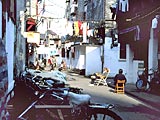 Moving for better living is what the city of 16 million residents has been doing to improve local housing conditions and enhance its international attractiveness.
Moving for better living is what the city of 16 million residents has been doing to improve local housing conditions and enhance its international attractiveness.
Shanghai officials have helped relocate 800,000 families since 1991 when the city decided to transform 3.65 million square meters of shabby houses into a modern-looking site.
Several generations of a family used to live under the same roof; the rooms were divided by cloth hanging from the ceiling.
During the past decade, many areas with such rundown houses have been turned into modern business centers with shining skyscrapers, apartments and green buffer areas.
Shanghai has a new profile.
The term "snail shell," once unique to Shanghai people, now is seldom used. Shanghai's residents' per capita living spaces have increased to 12.5 square meters from less than 4 square meters in early 1990s, indicate Shanghai Land, Housing and Resources Administration Bureau (SMHLRAB) figures.
"We ... used to huddle in a room of 14 square meters with my parents," said He Yaozu, director of the bureau's residential moving management office.
He had six brothers and sisters.
"It is unbelievable to children today or people from outside Shanghai, but it is something most local residents cannot forget," He said.
His family was relocated -- with some compensation -- in the 1990s to a larger home in accordance with an administrative law issued by the State Council.
Xiao Ye, 30, recalls having to fold up his bed each morning to ensure his parents and sister could get around their 13-square-meter home.
Xiao's sister eventually married and moved out. He now shares with his parents a three-bedroom apartment, but pans to move into another apartment after his wedding.
"We cannot afford a villa or finely furnished apartment. We want an apartment for about 4,000 yuan (US$480) per square meter. It must have a pleasant environment," Xiao said.
"Distance ... is not a problem as long as the apartment is along the metro lines," Xiao said.
Residents have been less concerned about distance and transportation since Shanghai's officials announced an ambitious program to construct 200 kilometers of rail line by 2005.
"Our work is to improve people's living conditions, and to help Shanghai grow into a strong, beautiful metropolis," He said.
Shanghai's visitors are generally amazed by the city's landscape, but few realize the parks and wooded areas were once polluting factories and squalid lanes, He said.
The inner, outer and middle ring roads, well-maintained highways, increased river crossings and continuously updated public-transportation vehicles have helped ease Shanghai's traffic congestion.
Several rural areas -- including Pudong, Jiading and Minhang -- have grown into prosperous residential and business districts.
"Shanghai owes its image to the people. They have supported the government," He said.
"We do everything by the law, and the law is for the people."
Shanghai established in 1991 its public reserve fund -- 42 billion yuan (US$5.1 billion) has been disbursed -- to compensate residents being relocated.
Housing prices have soared -- to 4,628 yuan (US$560) per square meter -- as more people, including international residents, have settled in Shanghai.
Officials are trying to cool prices, and to prevent a drain on the fund.
"The government is working to improve compensation methods and amounts to aid in the relocations," He said.
Xu Xiao has a sensitive nose; she can smell a person who has not had a shower in more than two days.
She recalls how bathing in her former residence was a humorous experience: She had to prepare 12 thermoses of hot water, put the water in a big wooden basin in the yard and have her mother stand guard.
She often felt proud despite the difficulties because her neighbors didn't have such a luxurious shower.
"Living with my parents, my mother's parents and my mother's brother and his wife was not easy, especially when I was 17," Xu said.
She also recalls how embarrassing it was to use the same chamber pot as a toilet with her parents.
Xu in 1995 moved with her parents to southwestern Shanghai, near the eventually built South Railway Station.
Her uncle eventually moved into an apartment near their former home. Xu's grandparents moved into a small apartment.
Cooking with coal stoves was common in Shanghai, and smoke-filled eyes and coughs pervaded many homes.
"There is no definite number of coal stoves that Shanghai had," said Gu Zhenyuan, a safety and renovation division expert with the SMHLRAB.
"I cannot say the past and present are two different worlds, but you can see how easy people have it now," Gu said.
Since the early 1990s, when the government changed basic requirements for people's living conditions, 3.65 million square meters of shabby housing, without gas and toilets, have been demolished.
Ninety-eight percent of Shanghai's households have during that period been connected with natural gas.
Most apartments have toilets and showers.
Shanghai will demolish 20 million square meters of old "linong" houses because they are between 60-70 years old and do not have adequate kitchens and toilets.
Ten million square meters of old housing have been identified as historic sites and will be renovated.
"Shanghai is such a promising city, and the government will take care of its people," Gu said.
(China Daily October 18, 2002)
|

